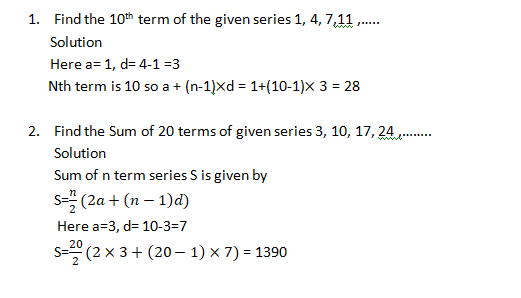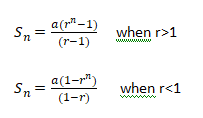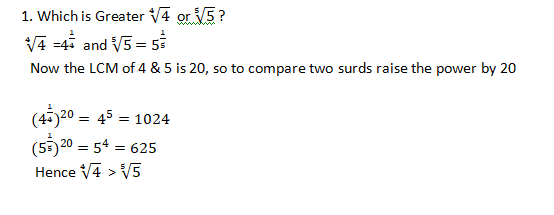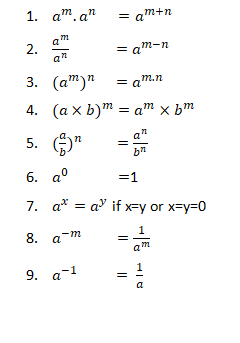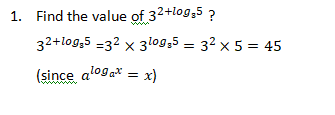Hello Friends, This is my Blog. In my blog I would like to share few concepts regarding Aptitude and Reasoning. Which is one of the important scoring concept of today's Competitive Examinations starting from SSC ,BANK PO/ CLERKS, RAILWAYS etc.
The 1st Concept is About NUMBER SYSTEM.
Types of Numbers
1. Natural Numbers-
Counting from 1, 2, 3,4 ..... etc are Natural Numbers.
2. Whole Numbers-
Counting from 0, 1, 2, 3..... etc are Whole Numbers.
3. Integers-
Counting from ........-3, -2, -1, 0, 1, 2 ,3,.... are Integers i.e. -infinity to +infinity
Positive Integers are from 1, 2, 3,.... and Negative Integers are from -1, -2, -3.....
4. Rational Numbers-
The Numbers of the form P/Q, where P & Q are integers and Q not equal to 0.
e.g- 2/3, -4/9 etc
5. Irrational Numbers-
The Numbers which are not in the form of P/Q or expressed in neither terminating nor repeating decimals are known as Irrational Numbers.
e.g- π, √3 etc
6. Real Numbers-
The Rational and Irrational Numbers combined together are called Real Numbers.
7.Complex Numbers-
These can be represented in the form of a+ib. where a and b are real numbers and i=√-1
8. Even Numbers-
These are the Numbers which can exactly divisible by 2.
9. Odd Numbers-
These are the Numbers which are exactly not divisible by 2.
10. Prime Numbers-
These are the Numbers which are divisible b 1 and itself.
11. Composite Numbers-
Two Numbers which are greater than 1 and which are not prime numbers.
e.g- 4, 6, 9 etc
12. Co-Prime Numbers-
Two Numbers which have only 1 as the common factors are called Co-Primes
e.g- (3,4), (8,9) etc
TEST FOR DIVISIBILITY
In this Concept we learn how can we identify which number is divisible by which number
1.Divisible by 2
A Number is said to be Divisible by 2 if the Unit Digit is Zero or Divisible by 2.
e.g- 22, 680, etc
2.Divisible by 3
A Number is said to be Divisible by 3, if the sum of the digits is divisible by 3.
e.g-2652 etc
2+6+5+2= 15 i.e divisible by 3 hence 2652 is divisible by 3
3.Divisible by 4
A Number is said to be Divisible by 4 if its last two digits are divisible by 4.
e.g- 584 etc
84 is divisible by 4 and answer is 21, hence 584 is divisible by 4
4.Divisible by 5-
A Number is said to be divisible by 5 if its Unit digit is either 0 or 5.
e.g- 1005, 955 etc
5. Divisible by 6-
A Number is said to be divisible by 6 if the Sum of Digits is divisible by 3 and is also EVEN.
e.g- 8448
the number is even and 8+4+4+8= 24 which is divisible by 3. Hence 8448 is divisible by 6.
6.Divisible by 8-
A Number is said to be divisible by 8 if its last 3 digits is divisible by 8.
e.g- 47472 i.e.472 is divisible by 8 and answer 59, thus 47472 is divisible by 8.
7. Divisible by 9-
A Number is said to be divisible by 9 if sum of digits is divisible by 9.
8. Divisible by 10-
A Number is said to be divisible by 10 if its unit digit is 0.
9. Divisible by 11-
A Number is said to be divisible by 11 if the difference of sum of digit at odd places and sum of digits at even places is either 0 or divisible by 11.
e.g 1331, even place number 3 and 1 and odd place numbers 1 and 3 so (1+3)-(1+3) = 0
thus 1331 is divisible by 11.
H.C.F & L.C.M of Numbers
- H.C.F is Highest Common Factor of two or more numbers is the greatest number that divides each one of them exactly. It is also called Greatest Common Divisor (G.C.D)
- L.C.M is Least Common Multiple of two or more numbers is the least or lowest number which is exactly divisible by each of them.
Counting of Number of ZERO'S
Procedure with example-
For example we have to count the number of zeros at the end of the value
10! = 10*9*8*7*6*5*4*3*2*1 i.e. Basically we count number of fives, because multiplication of five by an even number result in 0 at end product. thus in 10! we have 2 fives i.e 5 as a number and 10 written as 2*5 thus there are total 2 zeros at the end result.
Cyclicity
It is used to calculation of Unit digits
These are the few concepts of Number systems. If you'll like my concept do like and share.
And keep waiting for more Blogs
Thank-You!



